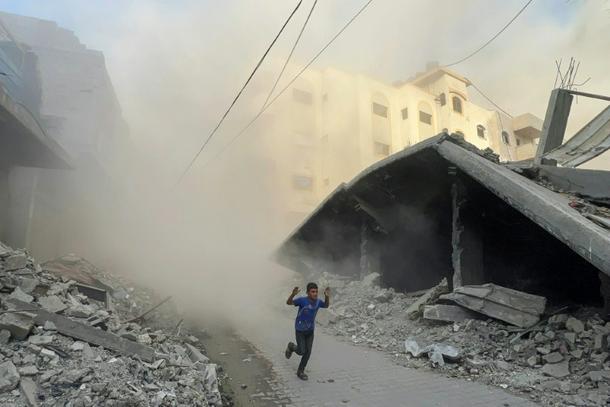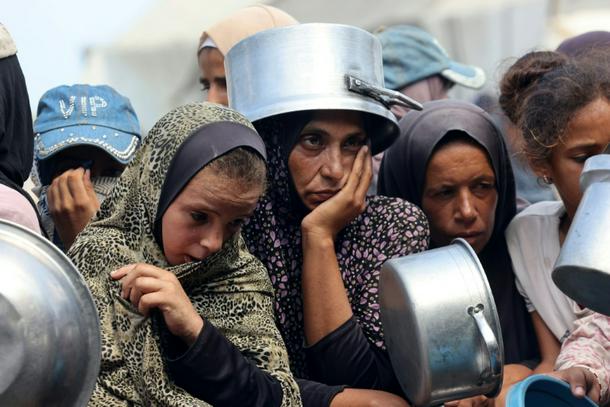
A Palestinian boy rushes away from the site of Israeli air strikes on a six-storey building in the Saftawi neighborhood west of Jabalia
Gaza-Israel border (Palestinian Territories) (AFP) - Israel hammered Gaza City and its outskirts overnight, residents said Thursday, as the military announced it had taken the initial steps in its push to capture Hamas’s last major stronghold.
The newly approved plan authorises the call-up of roughly 60,000 reservists, deepening fears the campaign will worsen the already catastrophic humanitarian crisis in the Gaza Strip.
“We are advancing with the efforts toward operations in Gaza City,” military chief Eyal Zamir told troops on Thursday.
“We already have troops operating on the outskirts of the city, and more forces will join them later on.”
Israel’s plans to expand the fighting and seize Gaza City have sparked international outcry as well as domestic opposition, with the Red Cross joining the condemnation on Thursday, calling the moves “intolerable”.
Ahead of the offensive, the Israeli military said the call-up of the reservists would begin in early September, adding the second phase of operation “Gideon’s Chariots” had begun.
Gaza City residents described relentless bombardments overnight.

Palestinian women and children wait to receive food from a charity kitchen, in Khan Yunis in the southern Gaza Strip on August 21, 2025
“The house shakes with us all night long – the sound of explosions, artillery, warplanes, ambulances, and cries for help is killing us,” Ahmad al-Shanti told AFP.
“The sound is getting closer, but where would we go?”
Another resident, Amal Abdel-Aal, said she watched the heavy strikes on the area, a week after being displaced from her home in Gaza City’s Al-Sabra neighbourhood.
“No one in Gaza has slept – not last night, not for a week. The artillery and air strikes in the east never stop. The sky flashes all night long,” she added.
Gaza civil defence agency spokesman Mahmud Bassal said air strikes and artillery fire overnight targeted areas to the northwest and southeast of the city.
- ‘Recipe for further disaster’ -
A group of AFP journalists near Israel’s border with Gaza also witnessed an air strike by a fighter jet on the northern outskirts of Gaza City on Thursday afternoon, with a massive explosion followed by a large plume of smoke rising into the sky.
Several sporadic explosions were heard afterward but it was not possible to determine their origin.
Strikes increased in pace later in the afternoon with several large explosions heard near the border.
In a statement Wednesday evening detailing a range of operations across Gaza in recent weeks, the army said it had created the conditions for intensifying pressure on Hamas and laid the groundwork for the next stages of the campaign.
The UN humanitarian agency has warned the Israeli plan to expand military operations in Gaza City would have “a horrific humanitarian impact” on the already exhausted population.
“Forcing hundreds of thousands to move south is a recipe for further disaster and could amount to forcible transfer,” OCHA said.
Others reportedly “remain trapped, completely cut off from food, water and medicine supplies”, it added.
The Israeli military said this week it had also begun informing medical personnel and aid groups in northern Gaza to start making evacuation plans and transferring their equipment to the south.
The Gaza health ministry, however, rejected that call on Thursday, saying it would not agree to “any step that would undermine what remains of the health system after the systematic destruction carried out by the occupation authorities”.
- Awaiting a response -
As Israel tightened its grip on Gaza City’s outskirts, meditators were still waiting for an official Israeli reaction to their latest ceasefire proposal, which Hamas accepted earlier this week.
Israel and Hamas have held indirect negotiations throughout the nearly two-year conflict, paving the way for a pair of short ceasefires during which Israeli hostages were freed in exchange for Palestinian prisoners.

A man carries a poster as Palestinians wave their national flag in a protest in Gaza City on August 21, 2025
Of the 251 hostages seized during Hamas’s October 2023 attack on southern Israel that triggered the war, 49 are still in Gaza, including 27 the Israeli military says are dead.
Sources from Hamas and its ally Islamic Jihad told AFP this week that the latest ceasefire proposal calls for the release of 10 hostages and 18 bodies from Gaza. The remaining hostages would be released in a second phase alongside talks for a wider settlement.
Israel, however, has insisted that any agreement involve freeing all the remaining hostages at once.
Late Wednesday, Hamas lambasted the plans to take control of Gaza City as showing Israel’s “blatant disregard” for efforts to broker a ceasefire and hostage release deal.
The Gaza civil defence agency said at least 48 people were killed on Thursday by Israeli attacks in various areas across the Palestinian territory, including several casualties in an air strike in Gaza City.
Hamas’s October 2023 attack on Israel resulted in the deaths of 1,219 people, mostly civilians, according to an AFP tally based on official figures.
Israel’s offensive has killed at least 62,122 Palestinians, most of them civilians, according to figures from the health ministry in Hamas-run Gaza, which the United Nations considers reliable.
Media restrictions in Gaza and difficulties in accessing many areas mean AFP is unable to independently verify the tolls and details provided by the civil defence agency or the Israeli military.